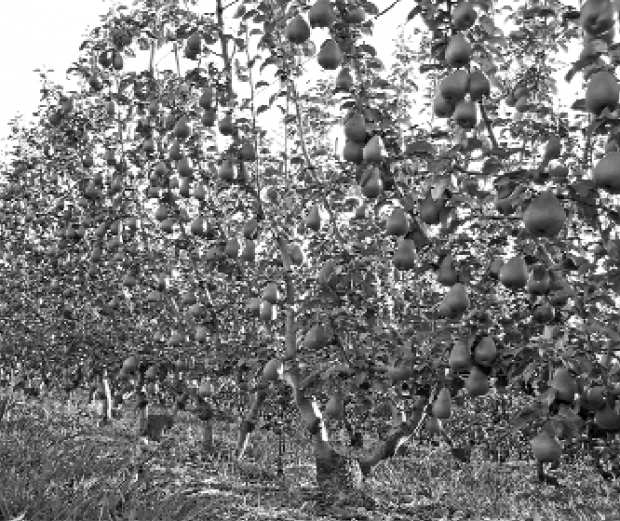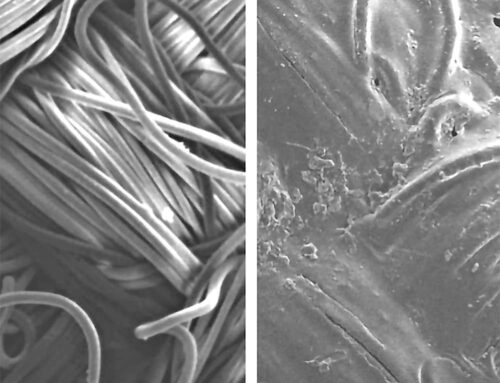
Eighteen-year-old Asian pear trees on mini-Tatura were regrafted to Forelle almost four years ago. The grafts on each tree were used to form four cordons, each 1 meter (3.25 feet) long. The trees are 2 meters (6.5 feet) tall.
The 1970s and 1980s saw an upsurge in the development of new training systems for growing fruit. Training systems were also hybridized to suit certain conditions and/or try to reduce the cost of establishing a high-density trellised orchard. New and hybridized training systems were developed to reduce the per-unit cost of production, to reduce the period between orchard establishment and commercial production, and to increase marketable yield per hectare. A concurrent need to improve size and quality of fruit added to changing perceptions about orchard training systems.
Since the cost of labor can represent more than half the cost of producing fruit, orchards also needed to become more labor friendly. The canopies of some training systems were designed to allow pruning and harvesting to be mechanized. Some of the training systems did not become popular, because they did not meet the listed objectives. To mechanically harvest and prune fruit trees in summer became insurmountable tasks that ultimately led to abandonment of the ideas. Most self-made platforms have had a history of failures. The versatile hydraulic-power ladder has become a better alternative, and is now commonly used in Australia to prune and harvest fruit trees.
Successes and failures have meant that the fruit industry is now benefiting from several training systems that meet the objectives and have endured the tests of time. One such training system is the Tatura trellis, which has been greatly modified over 32 years. For instance, the preferred angle of the V has changed from 30, to 22.5, and sometimes 17.5 degrees from vertical. As spacing between rows changed from 6.0 meters (20 feet) to 5.5 meters (18 feet) to 4.5 meters (less than 15 feet), trellises became lower, and angles between poles and the vertical became narrower.
Different versions
Different versions of Tatura-type orchards, such as the mini-Tatura and the open Tatura, were developed to cater to a wide range of fruit crops, conditions, and preferences. The open Tatura, where the trees alternate left and right, differs from the Tatura trellis. The open Tatura is open, because a narrow strip about 0.5 meters (20 inches) wide separates the diagonally planted trees within each row.
The Tatura trellis also evolved with different ways of arranging and training trees on the trellis, to reduce the cost of establishing a Tatura-type orchard and make it more cost-effective. For instance, to overcome the high cost of nursery trees, we halved tree density in an open Tatura by training each tree with two leaders (called open Tatura with twin leaders), compared with one leader per tree (called open Tatura with single leader).
While keeping the height of the canopy to a more manageable and cost-effective size, we have recently focused on controlling vigor of trees in the absence of size-controlling rootstocks. Dividing vigor over several fruiting units of equal size, cincturing, deficit irrigation at an early tree age, and early cropping, all inhibit tree vigor and contribute to the maximum control of the size of the trees. Cost of labor can be reduced by 10 to 45 percent when orchards are managed from the ground.
Labor efficiency as well as labor safety and preference have also become important considerations in the refined Tatura-type orchards. The unique design of the Tatura trellis and open Tatura has allowed the system to be refined and changed without sacrificing the listed objectives. All refinements were tested in demonstration blocks in orchards funded by the fruit industry, or by orchardists in their own orchards.
An example of this is the recently developed open Tatura with cordon by John Karl, co-owner of Bunbartha Fruit Packers Pty. Ltd. near Shepparton, Victoria, Australia. The author is now experimenting with the open Tatura with cordon with a wide range of fruit crops on several private and demonstration orchards. The fruit industry will continue to be influenced by a combination of economics and the market. The market increasingly requires large, tasty fruit that has good color (with the exception of green apples and pears), uniform firmness, high sugar content, and no skin defects. The open Tatura with cordon is another step toward meeting these market requirements.
Open Tatura
The open Tatura with cordon is trained differently from other Tatura-type trees. The open Tatura with cordon is simple and renews the bearing wood. The cordon method could be applied to Tatura trellis. However, the development of the cordon would be difficult and would take at least two years to establish before fruiting units could be formed. Tatura trellis trees that are grafted over to another variety can be trained to the cordon method.
More research is needed to evaluate benefits and economics of the cordon concept for Tatura trellis. The many versions and methods of training show the versatility of the Tatura system of growing tree fruit. Its popularity can be attributed to the many choices and preferences it offers to orchardists with different skills and requirements.




Leave A Comment